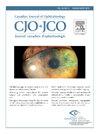评估作为白内障手术中囊膜破裂风险因素的玻璃体内注射。
IF 3.3
4区 医学
Q1 OPHTHALMOLOGY
Canadian journal of ophthalmology. Journal canadien d'ophtalmologie
Pub Date : 2025-02-01
DOI:10.1016/j.jcjo.2024.05.012
引用次数: 0
摘要
目的:确定在调整已知风险因素后,先前的玻璃体内注射是否是白内障手术后囊破裂(PCR)的独立风险因素:在对已知风险因素进行调整后,确定之前的玻璃体内注射是否是白内障手术中后囊破裂(PCR)的独立风险因素:设计:对一家大学转诊中心的人群队列进行单中心病历分析。奥地利格拉茨医科大学眼科系对 2005 年 1 月 1 日至 2020 年 12 月 31 日期间进行的白内障手术进行了回顾性队列研究:方法:将 2005 年 1 月 1 日至 2020 年 12 月 31 日期间为至少 18 岁患者进行的所有连续白内障手术纳入研究范围:方法:通过单变量和多变量广义估计方程(GEE)分析了既往玻璃体内注射与 PCR 发生率之间的关系。其他调查的风险因素包括年龄、合并手术、假性角膜剥脱、外科医生的经验以及白内障手术的类型:结果:与无玻璃体内治疗史的患者相比,曾接受过玻璃体内治疗的患者在白内障手术过程中发生后囊破裂的比例明显更高(OR 1.27,95% CI 1.10-1.46,P = 0.008)。然而,在对混杂的风险因素进行调整后,并未发现有统计学意义的影响(OR 1.04,95% CI 0.89-1.21,p = 0.664):结论:在对已知风险因素进行调整后,我们发现白内障手术中的玻璃体内注射史与 PCR 之间没有关联。需要进一步研究玻璃体内注射史与 PCR(尤其是假性角膜外翻)已知风险因素之间的相互作用。本文章由计算机程序翻译,如有差异,请以英文原文为准。
Evaluation of intravitreal injections as a risk factor for capsular rupture during cataract surgery
Objective
To determine whether previous intravitreal injections are an independent risk factor for posterior capsular rupture (PCR) during cataract surgery after adjusting for known risk factors.
Design
Single-centre medical records analysis of a population-based cohort at a university-based referral centre. A retrospective cohort study has been conducted with inclusion of cataract surgeries done from January 1, 2005 to December 31, 2020 at the Department of Ophthalmology, Medical University of Graz, Austria.
Participants
All consecutive cataract surgeries done in patients of at least 18 years of age from January 1, 2005 to December 31, 2020 have been included.
Methods
Association between previous intravitreal injections and PCR rates has been analysed through univariable and multivariable generalized estimating equations (GEE). Other investigated risk factors were age, combined surgery, pseudoexfoliation, surgeon's experience, and type of cataract surgery.
Results
A statistically significant higher rate of posterior capsular rupture during cataract surgery has been found in patients with previous intravitreal therapy compared with patients with no history of intravitreal therapy (OR 1.27, 95% CI 1.10–1.46, p = 0.008). However, after adjusting for confounding risk factors, no statistically significant effect was seen (OR 1.04, 95% CI 0.89–1.21, p = 0.664).
Conclusion
We found no association between history of intravitreal injections and PCR during cataract surgery after adjusting for known risk factors. Further studies upon interactions between history of intravitreal injections and known risk factors for PCR, especially pseudoexfoliation, are needed.
Objectif
Vérifier si les antécédents d'injections intravitréennes constituent un facteur de risque indépendant de rupture capsulaire postérieure (RCP) pendant une chirurgie de la cataracte après avoir tenu compte des facteurs de risque connus.
Nature
Il s'agit d'une analyse des dossiers médicaux d'une cohorte populationnelle provenant d'un centre universitaire de référence unique. L’étude de cohorte rétrospective regroupait toutes les chirurgies de la cataracte réalisées entre le 1er janvier 2005 et le 31 décembre 2020 au service d'ophtalmologie de l'Université médicale de Graz, en Autriche.
Participants
Toutes les chirurgies de la cataracte consécutives réalisées chez des patients d'au moins 18 ans entre le 1er janvier 2005 et le 31 décembre 2020 ont été incluses.
Méthodes
L'association entre les antécédents d'injections intravitréennes et les taux de RCP a fait l'objet d'une analyse reposant sur des équations d'estimation généralisées univariées et multivariées. Au nombre des autres facteurs de risque qui ont été étudiés, citons l’âge, la chirurgie combinée, la pseudo-exfoliation, le degré d'expérience du chirurgien et le type de chirurgie de la cataracte.
Résultats
On a enregistré une hausse statistiquement significative des RCP pendant la chirurgie de la cataracte chez les patients qui avaient déjà reçu des injections intravitréennes, comparativement à ceux qui n'en avaient jamais reçu (rapport de cotes [RC]: 1,27; intervalle de confiance [IC] à 95 % : 1,10–1,46; p = 0,008). Or, après avoir tenu compte des facteurs de confusion, aucun effet statistiquement significatif n'a pu être dégagé (RC : 1,04; IC à 95 % : 0,89–1,21; p = 0,664).
Conclusion
Aucune association entre les antécédents d'injections intravitréennes et la RCP pendant une chirurgie de la cataracte n'a pu être observée, après avoir tenu compte des facteurs de risque connus. On doit donc mener d'autres études sur les interactions entre les antécédents d'injections intravitréennes et les facteurs de risque connus de RCP, surtout la pseudo-exfoliation.
求助全文
通过发布文献求助,成功后即可免费获取论文全文。
去求助
来源期刊
CiteScore
3.20
自引率
4.80%
发文量
223
审稿时长
38 days
期刊介绍:
Official journal of the Canadian Ophthalmological Society.
The Canadian Journal of Ophthalmology (CJO) is the official journal of the Canadian Ophthalmological Society and is committed to timely publication of original, peer-reviewed ophthalmology and vision science articles.

 求助内容:
求助内容: 应助结果提醒方式:
应助结果提醒方式:


